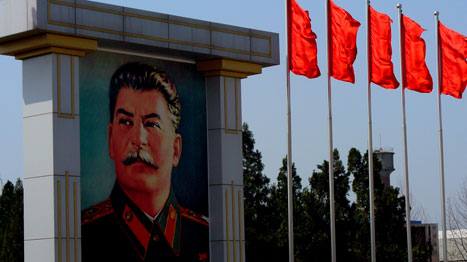With its smiling workers on bicycles passing beneath benign portraits of Mao Zedong, redder-than-red Communist songs broadcast on a loop and perky girls bustling about in revolutionary greens, all you need is a clear blue sky overhead and you’ve got a propaganda picture postcard from the 1950s.
If Nanjie Cun was your very first stop in China, you would be forgiven for demanding an immediate exit. But for anyone who has lived in China, travelled the land and witnessed the excesses of capitalism with Chinese characteristics, Nanjie Cun is a quaint and loveable oddity. You cannot help giving in to feelings of affection: there is no spitting, no shouting, no money (for bone fide Nanjie Cun citizens), no ear-splitting techno music pumping from shop fronts, no hawking, no beggars, and of course, no ‘hairdressers’ where girls sit vacantly, filing their nails.
Nanjie Cun is a small place which you can wander around in about three hours. The ideological zeal builds to a climax at East is Red Square (Dongfang Hong Guangchang), where a triumphant white statue of Mao Zedong (guarded round-the-clock by two armed soldiers) is flanked by portraits of Marx, Engels, Lenin and Stalin, the original ‘gang of four’ perhaps (although Twilight of the Idols also springs to mind). Walk north from here to wander through traditional-style Chaoyang Gate, decorated with a portrait of Sun Zhongshan (Sun Yat-sen) and observe how the Maoist broadcasts suddenly give way to the commercial racket of the street market in real China beyond. It’s like travelling through time.

The perfectly clean streets run in straight lines with a mind-numbing monotony but still manage an austere beauty, past noodle factories, schools and rows of identikit blocks of workers’ flats emblazoned with vermillion Communist slogans. One slogan endearingly announces: ‘A drop of water only needs to be part of a great ocean to never dry up; a person only has its greatest strength when part of a collective body’.
Prodded on by the ubiquitous slogans, workers go about their daily lives at the heart of Nanjie Cun with a convincing sense of purpose, creating a beguiling portrait of a workers’ paradise. Further out towards the southeast edge of town, however, everything seems to come to a standstill. There is little sign of economic activity in the factories and no sign of life in any of the worker’s flats. A cyclist comes past every ten minutes or so, followed five minutes later by a black VW Santana. It’s all rather eerie, like being on a set of a Chinese The Truman Show. Once the impression takes hold, one is reminded of reports in 2008 that Nanjie Cun had somehow amassed colossal debts and, coupled with rumours of extensive corruption, the village’s utopian shine took a sudden tarnishing.
Whatever the facts, Nanjie Cun still manages to conjure up something rather extraordinary and, when you don’t think you can handle yet another foreigner mark-up at the local market, pay a visit.
If you are overcome by Nanjie Cun’s proletarian kitsch, you can check into the white-tile Nanjiecun Hotel on the northeast side of East is Red Square, where the carpets are revolutionary red and girls in combat greens can lead you to classically old-style two-star hotel rooms.